Singapore Arts Festival 2010 Showcases Asian Cultures and Heritage
Miri International Jazz Festival: What's All That Jazz?
Miri International Jazz Festival 2010 Features James Cotton Blues Band, New Orleans All Stars, Ricardo Herz, Amina Figarova and Other Top Jazz and Blues Artistes
Claire Chiang on Culture and Conservation in Children's Literature
Gardon, Jouhikko, Nyckelharpa, Sape, Bamboo Pipes: World Music Celebration
Rainforest music festival highlights the sounds of cello-beating, hurdy gurdies and mouth organs.
By Michael Switow
SARAWAK, Malaysia — Nestled at the base of Mount Santubong, in a land made famous by the head-hunters, who only decades ago still fought here for honor, a Kenyah elder holds a dagger in his right hand and a hand-carved wooden shield in his left. He moves quickly, genuinely shocking his foe, a bare-chested Maori warrior, who moments earlier was intensely focused on the crowd in front of him.
Bats fly overhead.
Matthew Ngau is an artist and sculptor who rarely leaves his forested Borneo home and Te Hira Paenga is in training to become an Anglican minister, when he's not performing the Hakka and other traditional arts.
Only on the stage of the Rainforest World Music Festival is it likely that these two men would cross weapons. Cross-cultural surprises and jam sessions define this three-day festival, created 12 years ago to introduce Sarawakian musicians to the world and world musicians to Malaysia.
The festival also likely presents the world's best showcase of indigenous instruments.
“I'm looking to excite, amaze, enjoy, have a good time and also educate a little bit,” says artistic director and festival co-founder Randy Raine-Reusch. “This is a voyage of discovery for the audience. I want concert-goers to say `WOW, I've never seen that before!'”
The festival features an eclectic mix of bands including American country & bluegrass, East African drumming, Indonesian gamelan, Portuguese hard rock and Korean shamanistic tunes rarely heard outside traditional ceremonies. But every group has one common trait: each integrates indigenous instruments into its music. Some instruments have exotic names like the sumpoton, a free-reed mouth organ made with a calabash and bamboo pipes by villagers in northeast Borneo, or the hurdy gurdy, a European fiddle popular during the Renaissance which is played not with a bow but by cranking an attached wheel. Others like the Swedish nyckelharpa — an elongated fiddle with sixteen strings and an overlay of wooden pegs to control the pitch — are even more bizarre in appearance.
“These instruments are disappearing and I want that culture to survive,” explains Raine-Reusch, who plays hundreds of instruments as well. “I want to hear what that culture sounded like on the real thing. I'm not interested in hearing Balkan music on an electric guitar. I want to hear authenticity, even if it is in fusion music.”
Raine-Reusche estimates there are more than 5,000 instruments in the world — and that's if you don't count all the bells and rattles. Throw those into the mix and the count tops 10,000. At this year's Rainforest festival, 17 bands performed, yet only six used a guitar, well, seven if you count the one made from bamboo by Kinabalu Merdu Sound. Even fewer had a drum set.
Instead of drums, the Hungarian group Muszikas uses a gardon, an instrument that at first glance appears more suited to a string ensemble. The gardon player sets the tempo by hitting the instrument's strings with a stick. This “cello-beating” technique must have been tiring for traditional Hungarian musicians who earned their living by playing up to 40 hours non-stop at wedding parties.
This is not a festival of purists. Don't be fooled by the instruments. More than 20,000 music-lovers flock to the Sarawak Cultural Village each year for the Rainforest World Music Festival. Teenagers (and the not-so-young) dance for hours, but instead of partying to guitars, bass and drums, the mainstay of most pop bands, they jam to the sounds of the sapé, llimba and jouhikko.
(The sapé is a four-stringed instrument from Borneo whose lyrical melodies belie its cricket bat shape. llimba is an African thumb-piano, traditionally played by herders to mark their distance travelled. Jouhikko is a Finnish word, pronounced “yo-hee-ko”, for horsehair and Europe's oldest bowed instrument. )
“The tunes we are playing were really very cool two to three hundred years ago,” says jouhikko player Pekko Kappi. “We're still kind of shaking a little bit from how much fun we had,” says American musician Jeff Burke of the Jeff & Vida Band. “First of all, it's kind of packed here tonight, so there's a sea of people, in the middle of one of the most pristine areas that we've ever played a concert in. And the crowd here responds to what we do and music in general totally different than an American crowd would.”
Fans weaved a conga line through the crowd and sang along with every chorus, even though the tunes sung by Vida Wakeman in a raspy southern voice were original compositions they had never heard before.
“In the States, there's an etiquette, especially in bluegrass music” Burke explains. “ You sit quietly and listen and even if you love it and it's the best thing you've ever heard, you'll be quiet and when the song is over, you'll clap real loud and then stop really quickly so that the next song can happen, which always seemed nice until now, because it seems much more fun to have a crowd like this who kind of really throws themselves into the experience.”
Editors note: Visit our video section and picture gallery for more pictures and music from the event
Seeking Identities and Cultures in World Music
World Music Themes at Rainforest World Music Festival 2009
10 July 2009, Kuching.The sounds of World Music are intriguing backed by quaint strains of faraway bands playing with strange-looking musical instruments. What is more fascinating is the meaning behind the songs. We explore more into some of the stories and emotions that are carried in the songs performed at the 12th Rainforest World Music Festival held at the Sarawak Cultural Village.
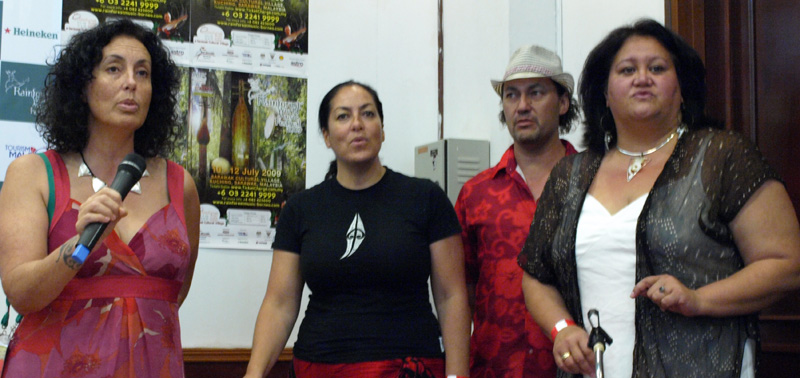
Moana & The Tribe from New Zealand.
For Moana & The Tribe, the Kiwis tell us that their songs are about spirituality, the environment and ancestors. “We see ourselves as guardians of the land and culture, the link between ancestors and the future,” says Moana the singer, composer and leader of the 12-piece band.
Her songs reflect the struggles faced by the Maoris.“Songs are a medium of storytelling; and we use songs to tell of the struggles of our tribes being marginalized.” She refers to the colonization of New Zealand were the Maori culture was chipped at and eroded.
A few songs question the state of things. One song, says Moana, urges “the keeping of traditional Maori names of mountains and rivers alive, formally and legally, not just within our people”. She spoke about the British renaming a mountain that was once called Aoraki to Mt Cook. Aoraki is the highest mountain in New Zealand at 3,754m in the Southern Alps.
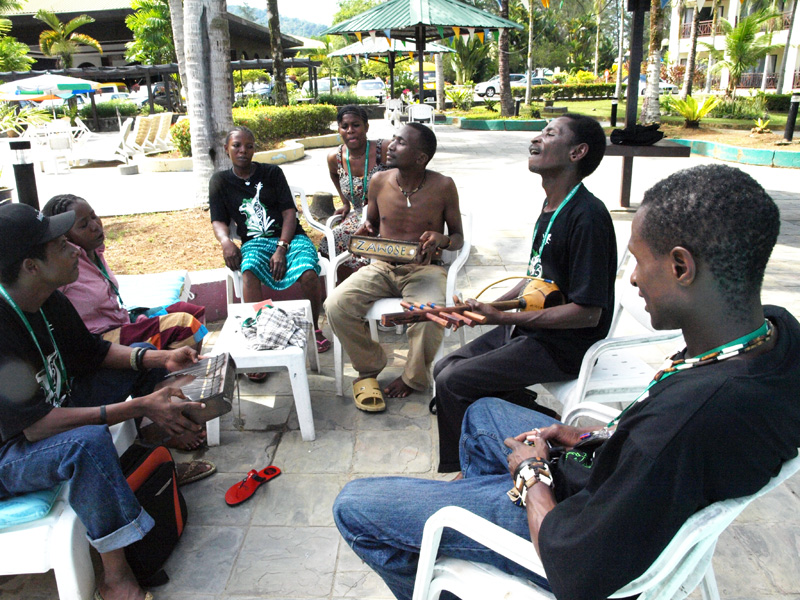
The Zawose family rehearsing poolside.
The song “Moko” addresses the difference between moko (Maori tattoo) and contemporary tattoo, to drive home the point that there is meaning in every indigenous moko carved on the skin of the Maoris. This is not to be dealt with flippantly or misused.
Vasco from Dazkarieh says his music unravels the differentways people relate to each other. He hopes to take a new approach in forging the relations between people. Some songs are about working in the field, and some religious. The Portuguese band revives songs played well before an oppressive Portugal regime 40 yrs ago that banned ethnic music.
The Zawose Family sings in Kigogo, their native dialect in Tanzania, retaining the old flavours of the African country before Swahili was nationalized as a unifying language. The late Hukwe Zawose composed songs that stirred the hearts of the people in taking pride in their country.

Robert Zawose
“We sing about the land, about nature, about people coming together, about life,” smiles Robert Zawose, then points to the tree. “See as we sing, even birds are coming.”
Even while keeping to age-old rhythm, listeners can appreciate their songs about the sufferings involved in the Hiroshima bombing as well as HIV disease. “Sumbu” is about how a woman feels when her child has lost her way, then is struck with memories of her difficult childbirth.
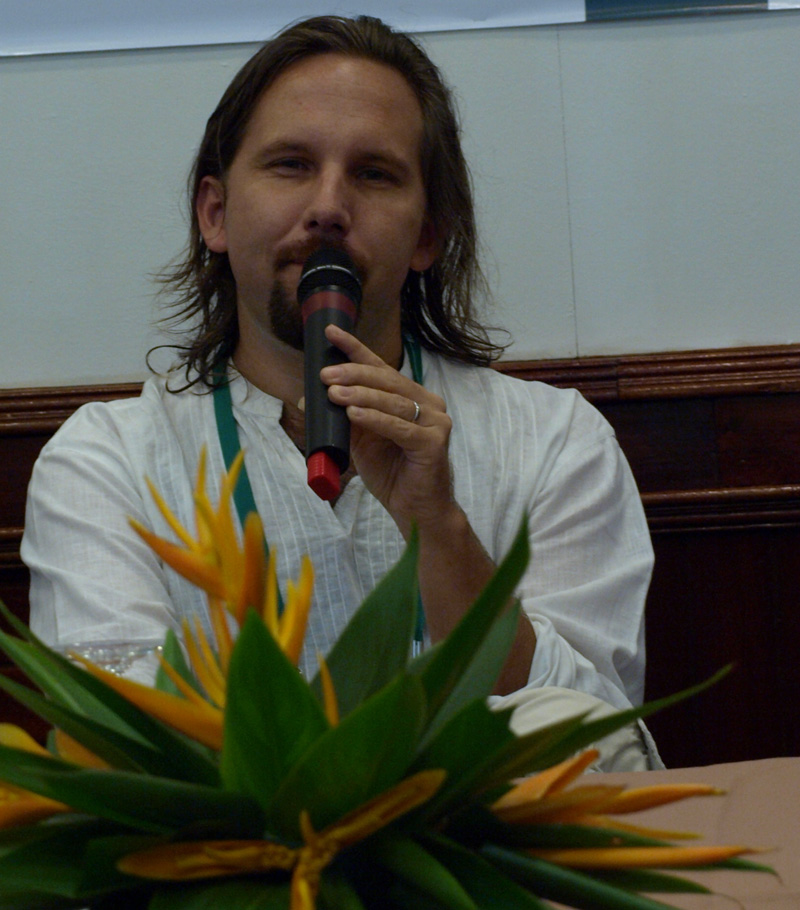
Akasha's James
Akasha from cosmopolitan Malaysia is a “rojak” instrumental band with skills in world music, classical and Latin Jazz. It becomes more interesting when the players who are ethnically Indians, Chinese and Caucasian playtraditional Malay music like the joget, and more contemporary tunes like blues, funk, jazz and Latin.
Guitarist James thinks music need not always have a story or a meaning. “Music has the effect of bringing out a story within people when they listen to it. It pretty much lies in the eye of the beholder; it's not limited by our own vision of it.”
Photos by Mallika Naguran.
See related articles on Gaia Discovery: Interview with festival director Randy Raine-Reusch on 2009 surprising finds; challenges faced by Sarawak Tourism Board before the opening of the 12th Rainforest World Music Festival.
Rainforest World Music Festival Puts Sarawak on the Map
Jazz Meets World Fusion at Miri International Jazz Festival 2009
Miri, 8 May 2009. At the fourth international jazz festival in oil town Miri, Sarawak, artistes fought jetlag and hangover late morning to respond to journalists’ questions on the role of traditional instruments in their sets, and how they would define jazz. They had flown in from various quarters of the world, to play, what the media (and 6,000 audience) expects to be jazz on 8-9 May 2009.
Except that the selection of bands this year raises a sticky question mark – a few seem to border on world music with gypsy, traditional dance, folk, even Afro pop.Accompanying generic jazz musical instruments were traditional ones. The sort that you would see being played at a Buddhist temple or an Indian classical opera.
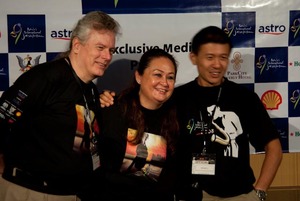
Randy Raine-Reusch, Gracie Geikie and Michael Lu plan surprises for all at the 4th Miri Int'l Jazz Fest, even for kids.
But this odd mix was done on purpose, according to the festival’s artistic director Randy Raine-Reusch who also shaped the Rainforest World Music Festival since its inception. “I’m introducing something new and am looking for excellence,” he tells the media, adding that the “balanced programme will be exciting for everybody, from straight-laced jazz to jazz funk, and more.”
Randy was appointed director of the 2009 jazz festival when his illustrious musical background became a little clearer to Sarawak Tourism Board and the organisers of the festival. He had after all dabbled with drum sets, trumpets, sax and possibly a hundred other instruments, studied with the best teachers in many countries, composed numerous scores including jazz pieces, and had recorded with some of the world's greatest crooners.
Jazz, as it appears, is hardly ceramic; instead, it is organic: wet, snaky, even quirky. Taking on forms, textures, colours and beats that arise from cultures, traditions, wisdom, peace, pain, angst, humour and quest for new horizons.
Pascal Seixas who plays double bass in Dites 34, thinks jazz is something of an enigma. “People are looking for new things, and using their music to communicate their lives,” he says. He thinks, however, that people are more open to traditional music than they are to jazz. Perhaps that’s why the band uses the cayamb, a square wooden shaker that originates from the Reunion Islands, along with the accordian, sax, drums and guitar, to express traditional dance music and French folk, along with contemporary jazz.
John Kaizan Neptune of Steps in Time isn’t too sure if his music can be classified as jazz. Having played in jazz and rock bands and the son of a jazz trombone player himself, John says he hears the sounds in his head and creates the texture. “I’m not sure if I call it jazz, but I hope people will enjoy it as much as I create it.”
He is sure of one thing though. “Jazz to jazz is like a language; musicians from other parts of the world may not understand the languages but music composition binds them together,” says John, the man who is world famous for taking a simple five-hole bamboo flute – the shakuhachi – and creating some mean notes from it, backed by a violin, percussion with Indian tabla and ghatam (claypot), and the all too familiar Western drum set. The product: quaint folklore strains at counterpoint with wispy jazz. “I think I can call my music multi-cultural,” he smiles.
South African-born Jeff Maluleke spoke of the origin of jazz as a protest by the blacks against slavery, singing soulfully as they toiled in the fields. ‘It is an expression of pain,” he says. The world touring guitarist, singer and songwriter brings across African themes with western musical instruments.
Jazz?
Maybe, maybe not. World fusion surely. But should we be worried about jazz festivals not sounding like jazz with all its wide-ranging glory from early eras of ragtime, swing, Dixieland, bebop to soul jazz, jazz fusion to free jazz? There’s of course the breakaway from mainstream jazz to subgenres and fusions, to localization. The festival’s a good place to start this discussion, and indeed, the media were rife with this thought even late into the night, and not necessarily finding a conclusion.
The artistes think we should lighten up and stop "putting music into boxes". Maybe we should. We could be a bit more free-ranging too, in our thinking, and our appreciation of musical creations. Expect the unexpected in a Sarawakan festival – World or Jazz - where the element of surprise seems to hang in the air like the magical sunset at Miri.
Bombay Baja Brass Band summed up the discussion by quoting legendary Louis Armstrong who said, “There is two kinds of music, good music and bad music. I play the good kind.”
And oh yes, there were some really good music at the fourth Miri International Jazz Festival, and just one really bad – the Bombay Baja Brass Band (UK) themselves, with the lack of invention and finesse, absence of subtlety and technique, but lots of noise matched by tacky costumes.
Performing great acts at the festival were Alamode (Australia), Dites 34 (France), Double Take (Malaysia), Jeff Maluleke (South Africa), Rumba Calzada (Canada and South America), Thomson Big Band (Singapore), and Steps in Time featuring John Kaizan Neptune (Japan).
There was a tad of jazz in all for sure, and great big chunks of fun.
Photos by Imran Ahmad of Escape Inc.
Read preview of 4th Miri Jazz International Festival by Gaia Discovery here.
Exclusive interview with John Kaizan Neptune on Bamboo magic.
Contact Randy Raine-Reusch of ASZA.
Multi-cultural Sensations at Miri International Jazz Festival 2009
by Mallika Naguran
Singapore, 13 April 2009. Jazz lovers will appreciate Miri as the staging ground of one of the top music festivals in Asia – the Miri International Jazz Festival from 8-9 May 2009. The nature-rich destination of Sarawak is already alluring; add world-class jazz strains to rainforests and national parks, you get a mixture that is both intoxicating and unforgettable.
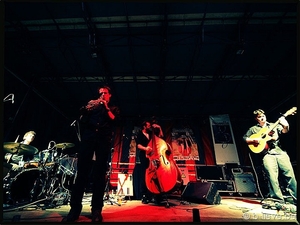
French dudes Dites 34.
The organisers, Sarawak Tourism Board, say that the festival, which is in its fourth year “promises to be another exciting event with wide repertoire of jazz genre”. Indeed the line up looks impressive (see below for full listing) with top bands keeling to kick up some profound blues, fusion, smooth, Latino to world. Leading artistes from around the world will blend heritage strains with musical acumen to get the audience tapping and bobbing away.
The Miri International Jazz Festival 2009 (MIJF) will feature the following performers: Dites 34 (France), Thomson Big Band (Singapore), Jeff Maluleke (South Africa), Alamode (Australia), Steps in Time featuring John Kaizan Neptune (Japan), Bombay Baja (India/England), Rumba Calzada (Canada) and Double Take (Malaysia). The festival is to be held at the Pavilion of the Park City Everly Hotel in Miri.
Miri is located in the northern part of Sarawak and attained its Resort City status in 2005. Often known as the Northern Gateway to Sarawak, the city is a popular base for visitors to explore the nearby national parks including Niah, Loagan Bunut and Lambir Hill national parks.The UNESCO World Heritage Mulu National Park is only a 45- minute flight away.
Jazz Line-up in 2009
Steps In Time featuring John Kaizan Neptune is a multi-cultural band that performs a mix of oriental, traditional and funky beats.John Kaizan Neptune has gained international reputation as the innovator on the Japanese bamboo flute, the Shakuhachi. One-sound-enlightenment shakuhachi blows with complex metre Indian drumming; cool jazz guitar glides with hot snaking Indian violin; funky wild bass grooves with rock steady drum set. At times calm or turbulent, free or calculated, a river of rhythm flows from multi-cultural Steps in Time.
Rumba Calzada was the crowd favourite last year.
Rumba Calzada is making its second appearance at the festival after being voted in survey as the crowd favourite in MIJF 2008. Led by Raphael Geronimo, the band had the crowd going crazy dancing to their blend of their Latino jazz with Afro Cuban rhythm.
Alamode - a six-piece jazz funk powerhouse - is reputed to deliver an amazingly tight and entertaining show.Known to always bring something new to each performance, Alamode is expected to woo the audience at the upcoming MIJF with their original funky tunes.
A leading Indian brass band in Europe, Bombay Baja Brass Band will create a carnival-like atmosphere with their unique style of combining popular Indian melodies with elements of jazz.Performing top Bollywood, Bhangra and Punjabi tunes as well as Indian wedding songs, Bambay Baja Brass Band will definitely entertain MIJF revelers who are Bollywood fans.
Jeff Maluleke is an award-winning South African guitarist, singer and songwriter. Although his music is very much afro-centric in character, Jeff Maluleke has also infuses a range of influences including Western tempo to create a distinct aesthetic that is sure to appeal to all music lovers.
Dites 34 performs a unique blend of traditional French folk music, contemporary jazz and pure energy.Making their Asian debut at the MIJF 2009, members of Dites 34 are no strangers to the music scene having shared the stage with some of the world’s leading artists during their tours of Europe and Mexico.
Thomson Big Band from Singapore.
A household name in Singapore jazz scene, the Thomson Big Band has also created a name for themselves outside the republic after having performed in major jazz festivals and events in Japan, Australia, India and Thailand.
Nearer to home is the Double Take duo of Roger Wang and Mia Palencia who are familiar faces in the local jazz scene in Malaysia. Combining Roger’s jazz guitar wizardry and Mia’s rich and sultry voice, the two will present their music in a pure and intimate form, performing jazz standards and original works.
More information:
Visit Miri International Jazz Festival website for further show and performer details. www.mirijazzfestival.com
Organisers Sawarak Tourism Board www.sarawaktourism.com
Tickets for adults are priced at RM60 per day and RM100 for a two-day ticket. Tickets for children between three and 12 years old are priced at RM30 per day and RM50 for two days. The two-day ticket will only be available until 25 April 2009. Following this date, only daily tickets will be on sale.
Tickets are also available online at www.ticketcharge.com.my.
Getting There:
Malaysia Airlines and AirAsia flies daily to Miri from Kuching, Kota Kinabalu and Kuala Lumpur.
Miri is just one hour flight away from Kuching, the capital city of Sarawak. Kuching, the main gateway to Sarawak, is also accessible via direct flight by Air Asia, Tiger Airways, Silk Air, Batavia Air, Royal Brunei Airways and MAS from Kuala Lumpur, Kota Kinabalu, Singapore, Jakarta, Macau, Pontianak and Brunei Darussalam.
Spirits Soar at Sarawak Rainforest World Music
by Mallika Naguran
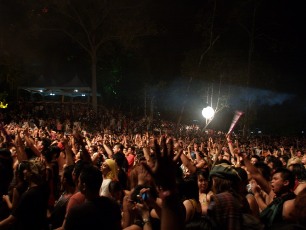
What’s a Rainforest Festival without some rain?
That’s the attitude that got half the audience up on their feet, grooving at the 11th Sarawak Rainforest World Music Festival 2008. Squelching ankle-deep mud could not stop them, while the rest – families, locals, foreigners from around the world – picnicked on sheets and mats on drier grounds, enjoying the party atmosphere from afar.
After all, this was the time they had waited oh so impatiently to be at Sarawak where the magic of music uncurls. Torrential rain on the opening day after ten consecutive years of great weather marked a first; in fact, organizers considered it bad timing. It was very, very, very wet.
However, musician Jean Claude from Kasai Masai was of the mind that it was auspicious. “If you don’t mind, I will tell you that in Congo where we come from originally, it rains everyday. This is because of the equatorial rainforest which is a lot bigger that Sarawak’s. Let me tell you that we, performing here for the first time, have brought our rainforest spirit with us. It is no coincidence.”
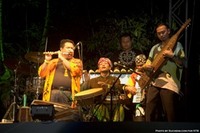
Tuku Kame of Sarawak.
It is hardly coincidental that the event brought together diverse spirits and cultures to produce colliding sound waves.
Foreign bands, 12 of them, and five local groups, oozed non-stop wide-ranging sounds such as traditional, folk, fusion, Celtic, rock, Baul and Socca.
The performers were New Rope String Band (United Kingdom), Yakande (Gambia/Guinea), Pinikpikan (The Philippines), Adel Salameh (Palestine), Ross Daly Quartet (Greece), Fadomorse (Portugal), Kasai Masai (Congo), Hiroshi Motofuji (Japan), Oikyataan (India), Beltaine (Poland), Sheldon Blackman and The Love Circle (Trinidad & Tobago).
Malaysian bands were Akasha, Anak Jati Bisaya Orchestra, Kan’id, Senida and Tuku Kame.

Pinikpikan thumps through hearts.
Appreciating the spirit of the community, environment, even the wild, form part of Pinikpikan’s life values. Guitarist and group director Samy of Pinikpikan talked about whales being poached and killed, and his song Butan Ding renders this point. “It’s a huge beast, yet it is vegetarian, eating plankton. So why kill it?” he asked.
The eight-member band from The Philippines spread the message of whale protection with traditional musical instruments such as the tungatong (bamboo shaker), derbuka (drum) and kutyati (two-stringed instrument from Mindanao) with Western instruments through an eclectic mix such as Afro-Cuban, Arabic and Asian.
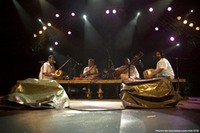
Hendrix reinvented with Akasha.
They were among the youngster favourites who also included Akasha (Malaysia), Beltaine, Kasai Masai and Sidney
Sheldon over the three-day concert from 11-13 July at Sarawak Cultural Village in Santubong. Taiko drummer Hiroshi Motofuji put on a pounding performance with a spread of drums, including the Indian mridhangam with mastery of interpretation.
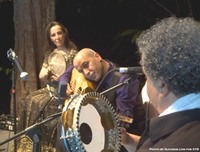
Adel Salameh trio thrill.
Oud player Adel Salameh’s finger work held me in awe, accompanied by wild honey vocalist Naziha Azzouz, an Algerian. I especially enjoyed watching their unassuming drummer play expertly on the tambourine in the opening solo – a simple instrument we often take for granted – yet capable of soaring the spirit.
Photos by Foto Polo Singapore (www.travel-Malaysia.com) and Suchens.com for Sawarak Tourism Board.
Make plans now to attend the 12th Sarawak Rainforest Music Festival on 10-12 July 2009. Fringe events being planned in town, plus spend time at the world craft bazaar and folk art forum. Hotels get full during the event, so make plans early. And while you are in Sarawak, visit their many eco destinations.
Coming soon: recommended eco destinations in Kuching and Sarawak.
Malaysia Boleh - Penang World Music Festival
Story by Mallika Naguran

Penang rocks!
To paraphrase, it’s “Malaysia can”. This arm-thrusting slogan was coined to reflect Malaysia’s sentiment to conquer all odds.
Politicians grunt it, and so do foreign music performers, apparently, when they feel the masses move beneath their hands.
And move they did the hearts, bodies and minds of bright-eyed Asian folks at the second annual Penang World Music Festival held at the charming quarry garden flanking the Botanical Gardens in Penang Island. Young and old bobbed and grooved to the strains, vocals and rhythm of 11 international bands from Croatia, Reunion Islands, France, Kenya, Denmark, Tibet (famed and exiled Techung), Mexico, Iran, India, Canada and US of A. See line up below and watch this section for album reviews and interviews.
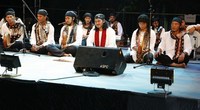
Rhythmic percussion by Kumpulan Dendang Anak.
The infectious Kumpulan Dendang Anak of Trengganu, one of the four Malaysian bands to be featured, roused the crowds to their feet with their gendangs, rebanas, konpangs and more. They proved that age-old traditions and heritage still, to this day, send a tingle. “We brought back folk music that existed 600-700 years ago that would have otherwise gone extinct,” beamed leader and performer Zulkifli Ismail who blends gongs and gamelans with the acoustic guitar.
“Everybody plays for tradition,” said Gilberto Guttierez of Mexican Mono Blanco, adding that where they come from, the farm, that is, happy hour equals song, dance and music, of course.

DYA Singh passes down generations of hymns.
Tradition need not be boring or out of date, and this perhaps is the beauty of world music where a bit of experimentation
fuses myriad of tones from different sound boxes. It doesn’t matter where it comes from, what it’s made of or which century it originated in. The tabla for instance, an ethnic Indian percussion instrument, served centre stage in DYA Singh played by world-renowned Nepalese-born Dheeraj Shrestra. The group mixes beats of tabla with Greek bouzouki, harmonium and the Australian didgeridoo. “The beauty of the group is the spirit of the music, dance and rhythm,” says Dheeraj. Watch Dheeraj perform this 10 May at Nepalese Pagoda, South Bank, Brisbane.
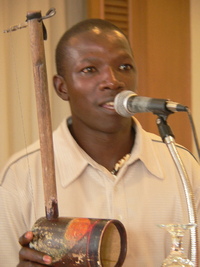
George Achiem resurrects oruto's appeal in Kenge Kenge.
Kenge Kenge’s dynamic leader and lead vocalist George Achiem resurrected a dying string instrument he saw being played in the market when he was a little boy. The one-string oruto provides a feminine counterpoint to pounding beats, between booming drums and calls of the rustic horn of this band from sunripe Kenya. “The whole band uses traditional instruments, some with eight strings, some with one. We really love our culture,” he grinned.
And so did we. For three days, Malaysians and tourists, even invited journalists, were mesmerized by the mind-blowing cultural experience. “This is what world music should be, full of ordinary people, children and screaming teenagers appreciating the acts, most of which are of very high standard,” said Singapore writer, actor and musician Joe Ng. “I stopped going to WOMAD of Singapore few years back because it became such a soulless, yuppie thing.”
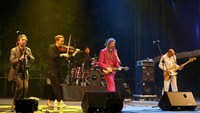
Electric and eclectic Afenginn infuse wild Nordic folk with Finnish nuances on the mandolin.
Even the absence of alcohol sale on the grounds did not deter anyone from getting a bit high during the three-day packed concert beginning May 2.
The music itself did the trick in lifting the spirits and screwing the brains (blame it on the Danish lot, Afenginn) with traditional instruments, lilting folklore, syncopated beats, surreal chants and head banging rhythms.
George Achiem best sums up the value of upholding traditions. “When we play our music overseas, we leave a bit of our culture behind and we learn new cultures from others.” This cultural exchange binds people together as they see beyond their inner worlds to understand and appreciate different perspectives.
“Music is the universal language, man,” said Brian the keyboardist of Techung as he pumped fists with Mame Khan, Badila’s Rajahstani singer at the post concert party. “I didn’t understand what you sang, man, but you know what, it didn’t matter. It’s all in the music, man.”
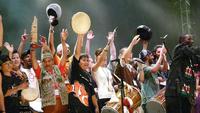
Music is the universal language.
I couldn’t agree more. If I were you, I’d make a date for the next Penang World Music Festival about the same time next year. Don’t forget to stay on for a few more days as Penang is lovely and harbours the best Malaysian food, like my favourite spicy sour assam laksa. Or if you can’t wait that long, head on down to the sizzling Sarawak Rainforest Festival 11-13 July. Book now to avoid disappointment - it’s a sell out I hear.
Akan Datang! Watch this space for more world music previews and reviews. View show video and more photos in Gallery.
Coming up soon: Afenginn on cheerful melancholy and rational madness. Only they can make this happen. Listen to their tracks here.
Coming up sooner: Internationally-acclaimed Techung writes the songs for Tibetan freedom
Gaia Discovery Rates the Show
Friday May 2 Day One
DYA SINGH (PENANG & AUSTRALIA) ***
TEADA (IRELAND) ****
KUMPULAN DENDANG ANAK (TERENGGANU, MALAYSIA) ***
MONO BLANCO (MEXICO) **
AFENGINN (DENMARK) *****
SALEM TRADITION (REUNINON ISLANDS) *****
Saturday May 3 Day Two
KUMPULAN KINABALU MERSU SOUND (SABAH) **
BADILA (IRAN, INDIA, FRANCE) ***
GALANT, TU PERDS TON TEMPS (CANADA) ***
DIPLOMATS OF DRUMS (KUALA LUMPUR, MALAYSIA) *
KRIES (CROATIA) ***
Sunday May 4 Last Day
TECHUNG (TIBET) ***** Watch videos
BALFA TOUJOURS (USA) ***
LO COR DE LA PLANA (FRANCE) *****
AFENGINN (DENMARK) *****
* Loo time
** Nice, but where’s the oomph?
*** You got me
**** Yeah baby yeah
***** Call the police. Roof is falling down here!
This show was made possible by the Ministry of Tourism Malaysia and Penang Tourism Action Council. It was made successful with resourceful festival artistic director Yeoh Jun-Lin and brilliant sound producer Niall Macaulay of Cheer Productions.
Photos by Joe Ng, Tourism Malaysia and Mallika Naguran

